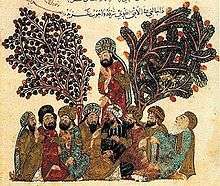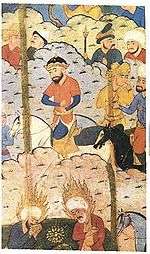Badi' al-Zaman al-Hamadani
Badi' al-Zamān al-Hamadāni or al-Hamadhāni (Arabic: بديع الزمان الهمذاني التغلبي; 969–1007) was a medieval Arab man of letters born in Hamadan, Iran. He is best known for his work the Maqamat Badi' az-Zaman al-Hamadhani, a collection of 52 episodic stories of a rogue, Abu al-Fath al-Iskandari, as recounted by a narrator, 'Isa b. Hisham. His Arabic name translates into "The Wonder of the Age".


Life
Very little is known about Al-Hamadani’s early life and primary sources are very limited. The main biographical account comes from the Persian scholar, ath-Thalibi, and most later biographies are derived from that.[1] According to al-Hamadani’s own account, he was of Arabic descent and his family had some education, but scholars have disputed these bare facts.[2] He claimed to be of Arabic descent, and traced his ancestry to the tribes of Taghlib and Mudar.[3] He was probably born and educated in Hamadan, Iran.[4]
More is known about Al-Hamadani’s adult life. In 380/990, al-Hamadhani, then aged 22, left his native city and began travelling to the various centres of learning. At the time, scholarly travel was an accepted practice for young, educated Arabic men. His first stop was at Rayy, possibly to meet up with his former mentor, Ahmed Ibn Faris (ref: Prendergast gives the instructor’s name as Abdul Husian ibn Faris; See https://archive.org/details/in.ernet.dli.2015.50447/page/n17). There he came under the patronage of Dihkhuda Abu Aid Muhammad ibn Mansur al-Isma (d. 410/1019). He next travelled to Jurjan where he began writing maqamat and where his literary talents found a receptive audience.[5]
In 383/992, he travelled to Khorasan, Nishapur, then under Samanid rule, and an established centre of literature. His experience of Khorasan was mixed. He was robbed several times by highwaymen, losing all of his possessions. However, his literary output became more prolific. He was in competition with al-Khawrizmi and eventually fell out with him. In Nishapur, he achieved great fame and his reputation spread throughout the region.[6]
After Nishapur was conquered by the Ghaznavids he departed the region and returned to his travels. On the road, he stopped at Sarakhs, Tus and Marw. Some early sources, such as the Persian scholar, ath-Thalibi, suggest that Al-Hamadani also visited Sijistan and Ghazna. However, very little is known of such travels and reliable evidence is thin, leading scholars to caution that, as al-Hamadani’s fame grew, such visits became the stuff of legend.[7]
In 383/993, he stopped at Zaranj, where he was received at the court of the Saffarid ruler, Abu Ahmad Khalaf ibn Ahdmad. Al-Hamadani’s intentions were to eulogise the ruler, for which he was well rewarded.[8]
His movements, following his sojourn in Zaranj, are obscure. He eventually settled in Bushanj, near Herat where he married into the Abu-‘Ali Al-Husayn ibn Muhammad al-Khushnami, a local noble family and spent his final years . His literary output declined during his period of residency at Herat.[9] After he settled in Herat, he came under the protection of Abu'l-Hasan Isfaraini, who was the vizier of Mahmud of Ghazni, the sultan of the Ghaznavid dynasty. He died at Herat, at the age of forty. He was renowned for a remarkable memory and for fluency of speech, as well as for the purity of his language.
His letters were first published at Constantinople (1881), and with commentary at Beirut (1890); his maqamas at Constantinople, and with commentary at Beirut (1889). Selected letters have been published in works, such as Silvestre de Sacy's edition of six of the maqamas with French translation and notes in his Chrestomathie arabe, vol. iii. (2nd ed., Paris, 1827). A specimen of the translated letters can be found A. von Kremers Culturgeschichte des Orients, ii. 470 sqq (in German).
Literary work
Al-Hamadani wrote poetry and many of his letters have survived. He is generally regarded as the originator of the genre known as ‘’maqama”(sing) or ‘’maqamat’’ (pl).[10] Al-Hamadani’s maqama made use of anecdotes collected in the 9th century by earlier writers, such as al-Jahiz and al-Taniikhi, but had a narrator introduce the anecdote.[11]
Al-Hamadani’s innovation was to apply saj' (an ornate form of rhymed prose), to the retelling of secular anecdotes.[12] Until that time, saj’ had been confined to religious and political works.[13] The form was subsequently imitated by other Arabic poets and writers. A century later, the writer, Al-Hariri of Basra elevated the maqamat into a major literary art form.[14]
Al-Hamadani’s Maqama made use of anecdotes collected in the 9th century by earlier writers, such as al-Jahiz and al-Taniikhi, but had a narrator introduce the anecdote.[15] Al-Hamadani’s innovation was to apply saj’, to the retelling of secular anecdotes.[16] Until that time, saj’ had been confined to religious and political works.[17]
A total of 52 of al-Hamadani’s maqama have been preserved in manuscripts. Each maqama is a complete story, but maqama are often presented in a collection with an overarching theme. Each story has two main characters, the narrator, (usually Isa ibn Hisham) and a protagonist, (usually Abu I-Fath of Alexandria, who is a rogue and a trickster). Other characters, often historical characters, are introduced in different stories. The anecdotes, presented in al-Hamadani’s maqamat played into a growing interest in the activities of Arabic low-life, especially beggars, tricksters and criminals.[18]
The maqama follows a loose structure of seven parts, namely (1) Isnad, (2) general introduction, (3) link (4) episode (the core of the narrative), (5) recognition scene, (6) envoi and (7) finale.[19]
Stylistically, maqama employ Saj', a highly polished and elaborate prose. Parts of the narrative may be written in verse, while other parts are written in unrhymed, literary prose. Most of the verse used by al-Hamadhani was borrowed from notable poets.[20]
See also
- Maqamat Badi' al-Zaman al-Hamadhani
- Arabic literature
References
- Hämeen-Anttila, J., Maqama: A History of a Genre, Otto Harrassowitz Verlag, 2002 , p 15
- Hämeen-Anttila, J., Maqama: A History of a Genre, Otto Harrassowitz Verlag, 2002 , pp 16-20
- In a letter to the vizier of Mahmud of Ghazni, Badi' al-Zaman traced his descent back to the tribes of Taghlib and Mudar:
"... يقول في رسالة إلى الفضل بن أحمد وزير السلطان محمود، (إني عبد الشيخ واسمي أحمد، وهمذان المولد، وتغلب المورد، ومضر المحتد،) وكأنه يريد أن يقول إنه مضري الأصل، ولكن أسرته عاشت في تغلب. وفي رسالة إلى الشيخ أبي القاسم يعتذر عن التخلف عن الحضور بالزكام، ويقول عن رجل أسمه أبو الحسن يظهر أن اسمه سقط من الرسالة: (وما أشد استظهاري بخلافته وإن لم يكن من ولد العباس والله يبقيه علما للفضل) فيقول أبو القاسم في الجواب. (والشيخ أبو الحسن فوق شروط الخلافة، فان كان المستخلف تغلبيا، جاز أن يكون الخالف كسرويا) فالتغلبي هو الهمذاني نفسه. ودليل آخر أنه كتب إلى القاضي أبا الحسين علي بن علي: (أنا أمت إلى القاضي أطال الله بقاءه بقرابة، إن لم يكن عربياً فأبي وأبوه إسماعيل، وعمي وعمه إسرائيل، الخ)"
مجلة الرسالة/العدد 38/بديع الزمان الهمذاني - Lewis, ed. by B. (1986). Encyclopedia of Islam, Vol 3 (Photomechan. repr. ed.). Leiden [u.a.]: Brill [u.a.] p. 106. ISBN 9004081186.CS1 maint: extra text: authors list (link)
- Hämeen-Anttila, J., Maqama: A History of a Genre, Otto Harrassowitz Verlag, 2002 , pp 20-21; Prendergast, W.J., The Maqamat Of Badi Al Zaman Al-hamadhani, (1915), 1973, pp 3-4, https://archive.org/details/in.ernet.dli.2015.50447/page/n19
- Hämeen-Anttila, J., Maqama: A History of a Genre, Otto Harrassowitz Verlag, 2002, pp 21-24; Prendergast, W.J., The Maqamat Of Badi Al Zaman al-Hamadhani, (1915), 1973, pp 5-6, https://archive.org/details/in.ernet.dli.2015.50447/page/n19
- Jaakko Hämeen-Anttila, Maqama: A History of a Genre, Otto Harrassowitz Verlag, 2002, pp 27-28
- Hämeen-Anttila, J., Maqama: A History of a Genre, Otto Harrassowitz Verlag, 2002 , pp 28-29
- Jaakko Hämeen-Anttila, Maqama: A History of a Genre, Otto Harrassowitz Verlag, 2002, pp 29-30; ; Prendergast, W.J., The Maqamat Of Badi Al Zaman Al-hamadhani, (1915), 1973, p. 6, https://archive.org/details/in.ernet.dli.2015.50447/page/n19
- Beeston, A.F.L., “The Genesis of the Maqāmāt Genre”, Journal of Arabic Literature, Vol. 2, 1971, pp. 1-12, DOI:10.7813/jll.2014/5-1/5https://www.jstor.org/stable/4182866; Masarwah, N., “The Maqama as a Literary Genre”, Journal of Language and Literature, 2014, Vol. 5, No. 1, pp 28-32; Nicholson, R., A Literary History of the Arabs, Project Gutenberg edition, 2011, pp 329-30 https://www.gutenberg.org/files/37985/37985-h/37985-h.htm#Page_329
- Ozaki, K., ”Maqama as a Courtroom Play- Disguised Hero, Duped Judge”, Orient, Vol. XVll 2007, p. 128
- Roxburgh, D., “In Pursuit of Shadows: Al-Hariri’s Maqamat,” Muqarnas, vol. 30, 2013, p. 178, https://www.jstor.org/stable/42751920
- Beeston, A.F.L., “Al-Hamadhani, al-Hariri and the maqamat Genre” in: Julia Ashtiany, Gerald Rex Smith, T. M. Johnstone, Julia Bray, University of Cambridge, J. D. Latham, R. B. Serjeant, Cambridge University Press, María Rosa Menocal, Raymond P. Scheindlin and Michael Sells, Abbasid Belles Lettres, Cambridge University Press, 1990, pp 126-127; Vol. 2, 1971, pp. 1-12, DOI:10.7813/jll.2014/5-1/5https://www.jstor.org/stable/4182866; Masarwah, N., “The Maqama as a Literary Genre”, Journal of Language and Literature, 2014, Vol. 5, No. 1, pp 28-32; Nicholson, R., A Literary History of the Arabs, Project Gutenberg edition, 2011, pp 329-30 https://www.gutenberg.org/files/37985/37985-h/37985-h.htm#Page_329
- Hamilton, M., Representing Others in Medieval Iberian Literature, Springer, 2007, p. 37
- Ozaki, K., ”Maqama as a Courtroom Play- Disguised Hero, Duped Judge”, Orient, Vol. XVll 2007, p. 128
- Roxburgh, D., “In Pursuit of Shadows: Al-Hariri’s Maqamat,” Muqarnas, vol. 30, 2013, p. 178, https://www.jstor.org/stable/42751920
- Beeston, A.F.L., “Al-Hamadhani, al-Hariri and the maqamat Genre” in: Julia Ashtiany, Gerald Rex Smith, T. M. Johnstone, Julia Bray, University of Cambridge, J. D. Latham, R. B. Serjeant, Cambridge University Press, María Rosa Menocal, Raymond P. Scheindlin and Michael Sells, Abbasid Belles Lettres, Cambridge University Press, 1990, pp 126-127
- Prendergast, W.J., The Maqamat Of Badi Al Zaman Al-hamadhani, (1915), 1973, p. vii https://archive.org/details/in.ernet.dli.2015.50447/page/n9
- Jaakko Hämeen-Anttila, Maqama: A History of a Genre, Otto Harrassowitz Verlag, 2002, pp 45-50
- Jaakko Hämeen-Anttila, Maqama: A History of a Genre, Otto Harrassowitz Verlag, 2002, pp 54-55
Sources
- The Maqámát of Badí‘ al-Zamán al-Hamadhání.
- BADĪʿ-AL-ZAMĀN HAMADĀNĪ, Encyclopedia Iranica

External links
| Arabic Wikisource has original text related to this article: |
- The Maqámát of Badí‘ al-Zamán al-Hamadhání English translation at sacred-texts.com
Further reading
Hämeen-Anttila, J., ‘’Maqama: A History of a Genre’’, Otto Harrassowitz Verlag, 2002 (especially see pp 15-65 for a discussion of al-Hamadhani’s ‘’Maqamat’’.)